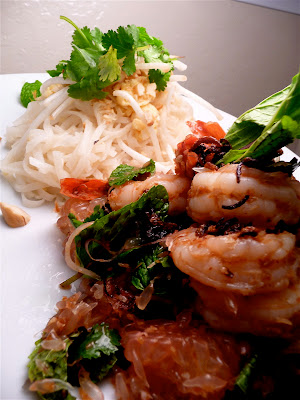 I have had my eye on this recipe for a while. I was only waiting to cross paths with the fabulous Citrus maxima. The pomelo, also known as Chinese grapefruit, jabong, shaddock, and pompelmous, is a large citrus fruit native to Southeast Asia. Ancestor to the grapefruit, the pomelo has a rich and intriguing history. Those who know them as "shaddocks" are invoking the name of the mid 17th century English sea captain who brought the fruit from Polynesia to the West Indies. The word "pomelo" can be traced back to the Malay pumpulmas, which became the Dutch word pompelmoes. Pomelos still grow wild in their native Malaysia and Indonesia, and there is evidence that they grew in China as early as 100 BCE. The fruit is part of the Asian family ritual and believed by the Chinese to be a sign of prosperity and good fortune. So, I'm going to start eating them all the time...I could use some extra prosperity.
I have had my eye on this recipe for a while. I was only waiting to cross paths with the fabulous Citrus maxima. The pomelo, also known as Chinese grapefruit, jabong, shaddock, and pompelmous, is a large citrus fruit native to Southeast Asia. Ancestor to the grapefruit, the pomelo has a rich and intriguing history. Those who know them as "shaddocks" are invoking the name of the mid 17th century English sea captain who brought the fruit from Polynesia to the West Indies. The word "pomelo" can be traced back to the Malay pumpulmas, which became the Dutch word pompelmoes. Pomelos still grow wild in their native Malaysia and Indonesia, and there is evidence that they grew in China as early as 100 BCE. The fruit is part of the Asian family ritual and believed by the Chinese to be a sign of prosperity and good fortune. So, I'm going to start eating them all the time...I could use some extra prosperity.In Thailand the pomelo is called som-oh (ส้มโอ), and its inclusion in this northern Thai salad is fantastic. This recipe comes from "The Food Of Thailand: A Journey For Food Lovers," available through the Amazon.com link at right. As often occurs with "ethnic" recipes, you may need to have a pantry stocked with ingredients that some of your friends have never even heard of. This one isn't outlandish, but it does require some extra effort, as it calls for a tablespoon of chili jam, which you'll have to make beforehand. Let's begin there then, shall we?
Chili jam--naam jaew
-oil for frying
-20 Asian shallots, sliced (I substituted French shallots)
-10 garlic cloves, sliced
-3 tablespoons dried shrimp
-7 long dried chilies, chopped
-3 tablespoons tamarind purée
-6 tablespoons palm sugar
-1 teaspoon shrimp paste (I couldn't find shrimp paste, so I omitted it)
Makes 1 cup.
Heat the oil in a wok and fry the shallots and garlic until golden, then transfer to a food processor. Fry the chillies and shrimp paste for 1 to 2 minutes, then add to the food pro along with the remaining ingredients and as much of the oil as necessary to make a pourable paste when pulsed. Put the paste back into the clean wok and bring to a boil. Reduce heat and simmer until thick. Be careful not to overcook or you'll end up with a caramelized lump. Season with salt or fish sauce. Chili jam is used as a base for recipes, especially stir-fries, as well as a seasoning or accompaniment. It will keep for several months in an airtight container in the refrigerator.

Now for the salad....
For the dressing:
-1 tablespoon fish sauce
-1 tablespoon lime juice
-1 teaspoon sugar
-1 tablespoon chili jam
For the salad:
-1 large pomelo
-10 oz. raw medium prawns, peeled and deveined, tails intact
-3 tablespoons shredded coconut, lightly toasted until golden
-3 Asian shallots, finely sliced (again, I substituted French)
-5 bird's eye chilies, bruised (I substituted serranos)
-1 cup mint leaves
-1/3 cup cilantro leaves
-1 tablespoon fried shallots
Boil the shrimp in a large saucepan for 2 minutes. Drain and set aside to cool. To peel a pomelo, cut a 3/4 inch disc off of the top then deeply score the skin into quarters. Peel away the skin, remove any remaining pith, and gently separate each segment (see wikihow for a more detailed description). In a large bowl combine the pomelo, prawns, toasted coconut, shallots, chilies, mint and cilantro. To make the dressing, combine the fish sauce, lime juice, sugar and chili jam in a small bowl and whisk to combine. Just before serving, add the dressing and toss gently to combine all of the ingredients. Serve sprinkled with fried shallots.
The flavors, though deep and complex, combine to make a beautiful and surprisingly subtle dish. I made a very simple veggie pad Thai noodle to accompany the salad. I also served a sparkling guava cocktail to further elevate the senses and wash everything down. I look forward to the day when I will once again be eating this salad...IN THAILAND!






































